Kyoto University Graduate School of Engineering
Department of Civil and Earth Resources Engineering
RESEARCH EQUIPMENTRESEARCH EQUIPMENT
Katsura Campus
Thermostatic and humidistatic experimental laboratory
Triaxial Compression test apparatus
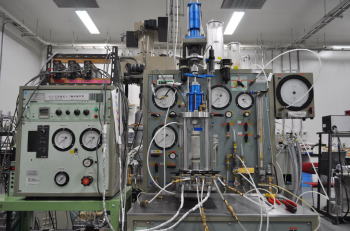 □Specification
□Specification◆Load range:4.9kN
◆Operating frequency:0.001~10 Hz
◆Pressure capacity:
(cell pressure)490 kPa,
(back pressure)490 kPa
◆Sample sizes:
50 mm in diameter, 100 mm in height
◆Measuring of volume change:
Water level in burette(25 cm3)
◆Measuring of displacement:
Axial displacement gauge(50 mm)
Gap sensor(2 mm)
◆Available test conditions:
Monotonic triaxial loading, Cyclic triaxial loading
◆Loading device:
Motor (monotonic loading)
pneumatic servo (cyclic loading)
□Research content
Monotonic triaxial loading test and cyclic triaxial loading test using pneumatic servo can be conducted by this test apparatus. Static deformational behavior, dynamic behavior and liquefaction characteristics of geomaterials are investigated using the apparatus.
Triaxial Compression test apparatus for unsaturated soil
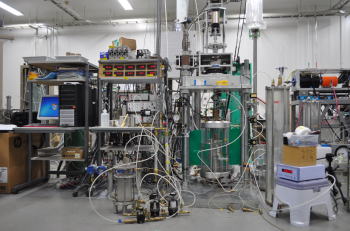 □Specification
□Specification◆Load range:
5kN (triaxial loading test)
5kN・cm (Torsional shear test)
◆Pressure capacity:1 MPa
◆Sample sizes(triaxial loading test) :
50 mm in diameter
100 mm in height
◆Sample sizes(torsional shear test) :
60 mm in inside diameter
100 mm in outside diameter
100 mm in height
◆Measuring of volume change:
Water level in a burette (saturated soil)
Axial displacement gauge for vertical displacement, gap censer and image processing for lateral displacement.
◆Loading device:AC servo motor (strain controlled test), belloframe cylinder (controlled stress test).
◆Unexhausted condition:Air operated value (in cell)
□Research content
Mechanical behavior of unsaturated soil is studied on difference from saturated soil and suction effects on the strength and deformation properties by this test apparatus.
Temperature controlled and high pressure triaxial compression test apparatus.
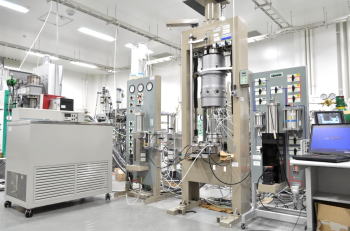 □Specification
□Specification◆Load range:200 kN
◆Pressure capacity:
20 MPa (cell pressure)
20 MPa (back pressure)
◆Sample sizes :
35 mm in diameter × 70 mm in height
50 mm in diameter × 100 mm in height
◆Measuring of volume change:
stepping motor controlled piston (saturated)
Double cell (unsaturated)
◆Measuring of displacement:
Axial displacement gauge (25 mm)
◆Loading device:stepping motor control
□Research content
CO2 hydrate containing sample are made under low temperature and high pressure. Triaxial compression behavior of the CO2 hydrate containing sample befor and after hydrate dissociation are studied by this apparatus.
Hollow torsional triaxial test apparatus
 □Specification
□Specification◆Load range:
3 kN (triaxial condition)
30N・m (torsional)
◆Operating frequency:0.001~10 Hz
◆Pressure capacity:1 MPa
◆Sample sizes(triaxial condition):
50 mm in diameter
100 mm in height
◆Sample sizes(torsional shear test):
60 mm in inside diameter
100 mm in outside diameter
100 mm in height
◆Measuring of volume change:Bullet
◆Measuring of displacement:Bullet
◆Available test conditions:Monotonic loading,cyclic loading
◆Loading device:Pneumatic servo
□Research content
Highly accurate prediction technique for liquefaction have been required after Tohoku earthquake. Associated with the liquefaction problem, triaxial shear test and torsional shear test are conducted under undrained condition using sand in Kizugawa embankment in order to study difference of liquefaction behavior between triaxial loading and torsional shear test.
Microfocus X-ray room
Microfocus X-ray Computed Tomography Scanner
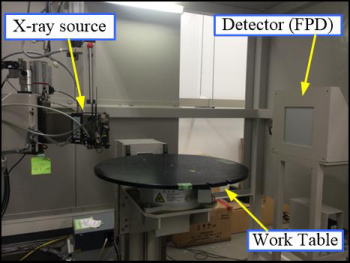 □Specification:μX-ray CT apparatus
□Specification:μX-ray CT apparatus◆Max. Voltege :225kV
◆Max. Current :0.888μA
◆Max. Electoronic power consumptioin :200W
◆Min. Focus size :4μm
□Specification:Flat Panel Detector (FPD)
◆Size of matrices:1024×1024,512×512,256×256
◆Resolution performance :5 μm
◆Integration time :66 ms - 999 ms
◆Feedback capacitance (gain) :0.25 pF - 8.0 pF
◆Pixel size :200 μm
◆Projection view :600 - 4800
◆Integration images :10 - 50
□Research content
In order to reflect to the macro kinematic model, for example the heterogenity and develpoment of shear bands during loading of geomaterials are microspically observed by μX-ray CT.
Uji Campus
Geotechnical Centrifuge Center at DPRI, Kyoto University
Centrifuge Model Testing Equipment(Device management:Prof. Iai Lab.)
 □Specification
□Specification◆Effective radius :2.5 m
◆Max payload :24 G・ton
◆Maximum centrifugal acceleration:200 G
◆Maximum number of rotations :260 rpm
◆Maximum payload at 50-g:(Static) 245.0 kg
(Dynamic)142.5 kg
□Research content
Geotechnical centrifuge modeling is one of the methods for small scale model testing to study behavior of soil and structures. By applying high centrifugal acceleration to a scaled model ground, a confining pressure of the ground in prototype scale can be simulated in a scaled model, which is one of the advantages of using a geotechnical centrifuge facility.
In our laboratoty, we are carrying out centrifuge model tests and numerical analyses for various civil structures, such as a group pile foundation, a culvert tunnel, and a reinforced earth to elucidate the soil-structure interaction and construct the rational design approach.
Strong Earthquake Response Simulator at DPRI, Kyoto University
Strong Earthquake Response Simulator(Device management:Prof. Kawase Lab.)
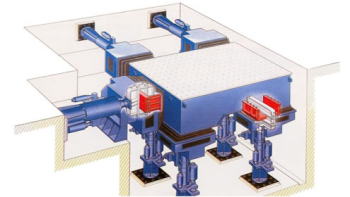 □Specification
□Specification◆Table:5m(X-axis) x 3m(Y-axis)
◆Shaking Direction:Horizontal 2 axis(X,Y), Vertical(Z), rotation(θx,θy,θz)
◆Driving Force System:
Electronic and Oil Pressured Servo System
◆Coupler System:Static Bearing
◆Maximum Load:
Rated Value 15tonf, Maximum Value 30tonf
◆Maximum Displacement X: ±300mm
Y: ±250mm
Z: ±200mm
◆Maximum Velocity X,Y,Z: ±150cm/s
◆Maximum Acceleration X,Y,Z:±1G(±1.5G without load)
◆Maximum Rotation Angle:(θx,θy,θz)±3 °
◆Frequency:DC ~ 50 Hz
◆Input Wave:Sine, Random, Arbitrary
□Research content
The shaking table can accurately simulate the response of complex structure systems during strong shaking. Shaking tests for small-scale full structure system model or full-scale structure or parts can be carried out. Especially, high velocity strong motion as well as high acceleration is possible. For each axis, the maximum velocity for continuous sine-wave shaking is ±50cm/s, but by using the accumulator, data observed at JMA Kobe during the 1995 Kobe Earthquake(Maximum acceleration: Horizontal 818cm/s/s, Vertical 332cm/s/s, Maximum velocity: Horizontal 90cm/s, Vertical 40cm/s) can be reproduced for simultaneous shaking of 3 axis(X,Y,Z).
In our laboratoty, large-scale shaking table test using a strong earthquake response simulator was conducted to clarify the seismic behavior of a hinged precast arch culvert. Furthermore, the inner space displacement and the earth pressure of the culvert were measured in each construction stage.
Kyoto Univ. Prof. Higo Lab.
Kyoto University
Geomechanics Laboratory
(Prof. Higo's Lab.)
Building 1, C cluster, Kyoto University Katsura Campus, Nishikyo-ku, Kyoto,
615-8540, Japan
Room 235(Prof. Higo)
Room 236(Assoc. Prof. Hashimoto)
Room 291(Assoc. Prof. Zhu)
Room 234(Asst. Prof. Lu)
Room 238(Students)